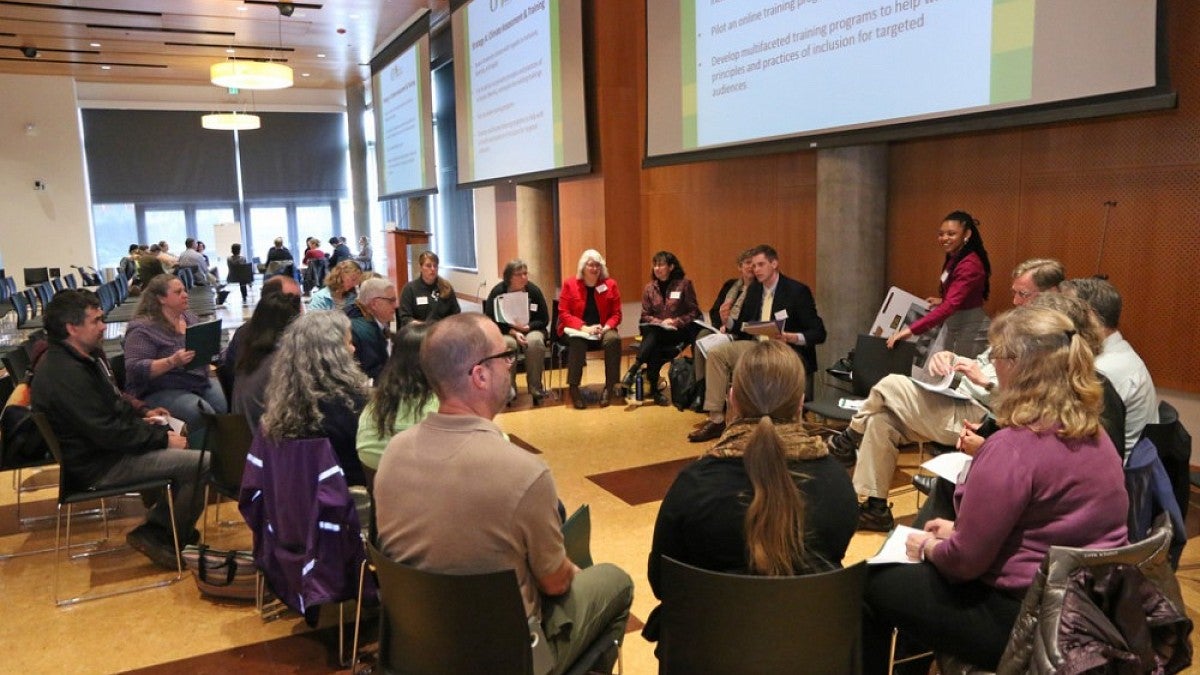More than 200 people attended an April 8 town hall meeting hosted by the Division of Equity and Inclusion to discuss the new universitywide diversity plan.
The document, which uses the acronym IDEAL — Inclusion, Diversity, Evaluation, Achievement and Leadership — as its guiding principle, “builds on the success we saw with the 2005 plan,” interim UO President Scott Coltrane said at the beginning of the forum.
Both Coltrane and acting Provost Frances Bronet emphasized that, as a public research institution, the university must focus on welcoming faculty, staff and students from diverse backgrounds. “It’s important that our arena of ideas be as multiple and far-reaching as possible,” Bronet said.
One way the plan does this is by defining diversity very broadly. It seeks to reach many groups traditionally underrepresented at the UO, including people of color, people with disabilities, women in science, LGBTQA people and religious minorities.
The campuswide diversity committee’s work kicked off with a town hall in October 2013, said Vice President of Equity and Inclusion Yvette Alex-Assensoh. In the months that followed, the Division of Equity and Inclusion held three community meetings to learn what a broad spectrum of stakeholders believed should be included in a new diversity plan.
With that information and feedback from the university’s leadership team, subcommittees and its writing committee, they were able to develop the plan.
Rather than asking campus units to create their own diversity plans, the IDEAL concept provides a framework for departments, Alex-Assensoh explained. Each unit will select from the menu of strategies and tactics within the plan options that fit best with their own strengths and priorities.
By limiting the amount of work involved in planning, Alex-Assensoh hopes this approach will allow every UO faculty and staff member to seamlessly step into leadership roles that allow them to play a bigger part in promoting equity and inclusion on campus. Her goal is to make it very easy for departments to incorporate issues of diversity into research, teaching and everyday lives.
“When I think about this day, it’s a day of celebration,” Alex-Assensoh said, pointing out that the plan focuses on all aspects of diversity from accessibility to class, religion, race and ethnicity, gender and much more. But she also referenced the book “Waiting to Exhale” by Terry McMillan to acknowledge that while much has been accomplished so far, much remains to be done.
Following presentations to the larger group, participants broke out into smaller groups to discuss each of the IDEAL topics. In a demonstration of the desire to be intentional about inclusion on campus, some facilitators invited people to participate in the increasingly common practice of sharing which pronouns they prefer. During the breakout sessions a common theme was the need to institutionalize the IDEAL framework in all aspects of the university.
“This is not just for those of us who identify as being a little different,” said James T. Chang, director of the Duck Career Network. “This is really about the entire community. Everyone has a role to play. Everyone is needed to affect the community, which will help us achieve that systemic change instead of that ‘check the box’ change.”
Although much of the day’s discussion focused on what to do going forward, participants in the leadership breakout session suggested that some good lessons can be learned from the past. Specifically, they pointed to the proactive approach of former UO President Richard Lariviere as an example.
Linda Hamilton, the president of the Eugene-Springfield chapter of Blacks In Government, noted that Lariviere made a point of meeting with all students of color. There were many occasions, she said, where he hosted her and members of the Black Student Union at his house.
“It was an automatic buy-in,” Hamilton said. “Before he even came here, he had that drive. He had that mind for diversity, equity and inclusion. He was just a light bulb. You didn’t have to convince him this was something important. It was a done deal.”
ASUO President Beatriz Gutierrez remarked that her administration has focused largely on promoting and increasing cultural competency on campus. She said the effort has been well received by students and is helping students of color feel more comfortable on campus.
University Senate President Robert Kyr asked a question that reflected his hope for the plan: “What can we do to create our university together and expand this draft into something that will inspire people on campus?” As feedback on the IDEAL plan comes in during the coming months, the Division of Equity and Inclusion believes the answer is simple: plenty.
View a draft of the IDEAL framework and share feedback here.
—By the Division of Equity and Inclusion


